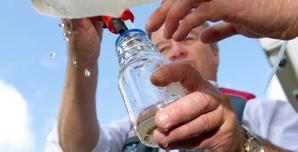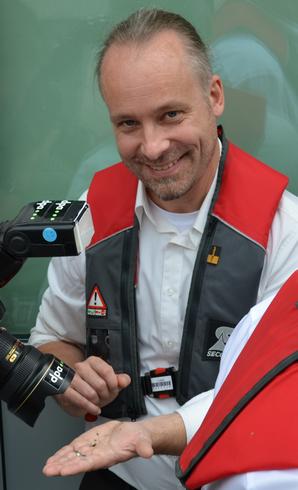David Vink
EUROPEAN PLASTICS NEWS
Published: October 21, 2014 1:16 pm ET
Updated: October 21, 2014 1:30 pm ET

Image By: Bayreuth University
University and regional environmental groups have been finding micro plastic particles in Lake Constance, Europe's third largest freshwater lake.
FRIEDRICHSHAFEN, GERMANY — While Fakuma 2014 exhibitors and visitors occupied themselves with topics like molding of micro-sized plastic parts during the show, the presence of micro-scale plastic particles several kilometers away in Lake Constance, Europe’s third largest freshwater lake, is occupying the minds of politicians and research institutes, if not also environmental activists and the general public.
The ISF institute for lake research, belonging to state of Baden Württemberg’s office for the environment, measurement and nature protection, is located along the lakeshore in the village of Langenargen.
Micro-plastics search has been added to one of ISF’s more conventional tasks — using advanced techniques to map the structure of the lakebed. This alone is no easy task, and it illustrates the difficulty of identification and dealing with possible micro-plastic particles, due to the sheer size and depth of the lake.
The lower and upper parts of the lake have average depths of 13 meters and 101 meters, with corresponding maximum depths of 40 meters and 253 meters. With its 545-square-kilometer surface, Lake Constance has a volume of 48.4 cubic kilometers.
ISF trawled the lake with its research vessel Kormoran in October 2013 to see what it would find. ISF chief Gerhard Schröder said previous trawls had not been aimed specifically at micro-plastic particles. Florian Fauer, a researcher from the EPFL environmental laboratory at ETH Lausanne Technical University in Switzerland, was on board and took surface water and sediment samples close to the shore.
Fauer has some justification in expecting to find some micro-plastic presence, based on experience elsewhere. He explained: “Researchers were alarmed after analysis of the beaches and water of Lake Geneva in 2012. Micro plastic remains were found in all samples.”
Aside from expanded polystyrene particles, the scientists found rigid plastic parts, plastic membranes, parts of anglers’ lines, as well as remains of hygiene and cosmetic products. These were at similar levels as in the Mediterranean, and ETH had intended to study fish as well for micro-plastic particles.
This is a clear sign that concerns about macro-sized and micro-scale plastic particles in the world’s oceans should equally extend to inland freshwater waterways and lakes, with Lake Garda in Italy said to be another victim.
Fauer’s colleague, Luiz Felippe de Alencastro, says: “We are also studying the possibility that absorbed hydrophobic pollutants on the surface of this plastic can also be liberated into the stomachs of birds and fish.”
Although the Austrian lakeside at the eastern end is much shorter, this has not prevented Austrian politicians claiming in November 2013 that 40 percent of the lakebed under Lake Constance’s water is covered with plastics waste. This was stated by SPÖ party members of the Austrian parliament’s upper house in Vienna, Stefan Schennach and Ewald Lindinger, to an upper house EU committee.

Image By: Bayreuth University
Christian Laforsch of Bayreuth University with some of the plastics found in Lake Constance.
Following the October 2013 trawl by ISF, Franz Untersteller, who is both a member of the Baden-Württemberg parliament and minister at the LUBW environment, climate and energy ministry, wrote a letter in November 2013 to the parliament’s president Guido Wolff on behalf of Thomas Maryein and other green party members, calling for the parliament to pay attention to micro-plastic particle analyses by Munich Technical University and Bayreuth University research teams.
LUBW has meanwhile announced on Aug. 8 the start of a project to take samples in Rhine and Neckar rivers and Lake Constance, in order to investigate the extent of micro-plastics presence. This will involve another ship, the Max Honsell, and is aimed at publication of the results by autumn 2015. Professor Christian Laforsch of Bayreuth University is assisting in the project.
Minister Untersteller stated: “Plastics have made a positive change in many areas of our lives, but plastics have, as do everything, a second aspect that increasingly causes problems for us. Plastics have an extremely long decomposition time of several hundred years. Many plastics that have got into the environment can still be found there today. We are leaving the coming generations a life long and unpleasant inheritance, the risks of which we can hardly estimate“.
In the August 2014 announcement, LUBW said an investigation on Lake Garda, Italy, had shown micro-plastics presence in sediment, which “made those responsible in Europe sit up and take notice, as it had been previously assumed that micro plastics was rather more a theme for the oceans.”
Untersteller continues, “As we take these facts very seriously from the political side, we have commissioned LUBW to investigate Baden Württemberg waters for presence of micro-plastics. When we have established knowledge here we can deal in a targeted way and draw the right conclusions — nationally and internationally”.
According to Laforsch, the plastic particles found on Lake Garda come mainly from consumer goods and packaging, reaching the lake surface water directly or through wrong disposal, where they “rot” and become micro-plastic particles.
Samples taken from Baden Württemberg’s waters and sediment will be first separated out according to density in a so-called MPSS Munich Plastic Sediment Separator developed by Bayreuth University and the Institute for Water Chemistry and Chemical Balneology at Munich Technical University. The Bayreuth University researchers will then “identify and quantify the micro-plastics present with different spectroscopic methods.” MPSS can extract plastic particles down to several micrometers. | 